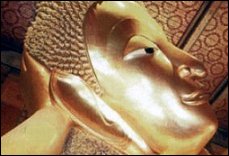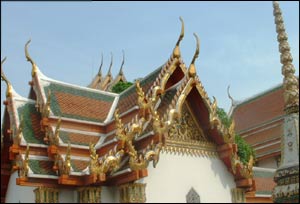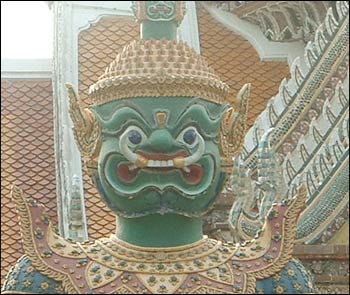Thai Massage School
Wat Pho (วัดโพธิ์), or Wat Phra Chetuphon (วัดพระเชตุพน) as it is generally known to the Thais, is mainly famous for the huge Reclining Buddha statue it houses. At 20 acres large, it is the largest Wat in Bangkok, and is technically the oldest too, as it was built around 200 years before Bangkok became Thailand's capital. However, today the Wat today bears virtually no resemblance to that originally constructed, as it was almost entirely rebuilt by Rama I when the
 capital was moved to Bangkok. It holds the dual honors of having both Thailand's largest reclining Buddha image and the most number of Buddha images in Thailand.
capital was moved to Bangkok. It holds the dual honors of having both Thailand's largest reclining Buddha image and the most number of Buddha images in Thailand. Massage - Wat Pho is also famous as Thailand's first university, and is center for traditional Thai masage - the rich, famous and powerful have all been known to come here. Inscribed on stone in the walls of Wat Pho are all that was known about Thai massage dating from the reign of King Rama III (most previous texts were lost when the Burmese destroyed Ayuthaya)
To get a traditional massage here costs 150B for 30 mins, 250B for an hour and herbal massages are available at 350B an hour. If you want to experience traditional Thai massage, this is probably the best place available and is highly recommended, though be aware that it's not exactly a gentle experience. A foot reflexology massage is also available at 250B for 45 minutes.
It is also possible to take courses to learn traditional Thai massage. These are for 30 hours and cost 4,500B. Courses can be spread over either 10 or 15 days. The massage center is situated at the back of the Wat, the opposite side from the entrance. To get a massage, simply turn up here and wait in line until a masseur is available - perhaps 10 or 20 minutes in the quieter periods in the early morning and late afternoon. Contact them on (+662) 221 2974 or (+662) 225 4771 if you need any more information about it.
 Details
Details The entrance to Wat Pho is on Chetuphon road. Entrance is 20B. It's open every day, opening hours are from 08.00am to 5.00pm, with a break from 12.00pm to 1.00pm. Guides can be hired at the entrance for 150B for one person, 200B for two, 300B for three, but they're not really needed. On Sundays, you can see students being taught traditional Thai dance and music.
Don't listen to anyone on the street as you try to enter telling you it's closed for a 'Buddhist holiday', 'cleaning' etc, or asking if you want to see the 'Lucky Buddha' instead - it's all part of a sophisticated gem scam.
Aircon buses 6, 8 and 12 all stop close to Wat Pho, and the Tha Tien express boat pier is very near. Ordinary buses that go near Wat Pho are ordinary buses 1, 25, 44, 47, 62 and 91 which stop on Maharat road. 44, 47 and 91 all stop on Thaiwang road, on the north side of Wat Pho, south of Wat Phra Kaew. It's also just a short river crossing away from Wat Arun. It's within walking distance of Wat Phra Kaew / Grand Palace, and (if you're feeling energetic) the National Museum too.
Wat Phra Kaew (วัดพระแก้ว), the Temple of the Emerald Buddha, and the adjoining Grand Palace together form perhaps the greatest spectacle for the visitor to Bangkok. Despite the fact that the whole compound is so full of tourists you spend half the time trying to avoid getting in people's photos, it's still a pretty amazing place to visit.
It consists of over 100 brightly colored buildings, golden spires and glittering mosaics, and dates back to 1782, when Bangkok was founded. When you enter the compound, you first of all see Wat Phra Kaew and the nearby attractions, and then move on to the Grand Palace afterwards.
Wat Phra Kaew itself, generally known to the Thais as Wat Phra Si Rattana Satsadaram, is perhaps the main attraction. This is Thailand's most important and sacred temple, so you're expected to act with due respect inside it. It houses the tiny (between 60 and 75 cm) Emerald Buddha, which is located high above the heads of the worshippers and tourists. Not much is known for certain about the statue, except that it isn't actually made of emerald but rather of green jade or jasper. Getting a good look at it is difficult as photography is forbidden inside the temple, and it's perched so high up inside it's glass box that it's difficult to really see.
It's thought to have been made in the 15th century and was the cause of several wars before ending up for good in Bangkok in 1782. The image is considered a talisman and holds tremendous significance for Thailand and the Thais. The 'robe' that it wears is changed 3 times each year by the King himself, at the start of each season: A diamond encrusted gold robe during the hot season, a solid gold robe in the cool season and a gilded monk's robe in the rainy season.There are also many other Buddha images inside the temple.
Round the interior walls are murals depicting the jataka stories. These are located according to the typical Thai conventions inside temples. The ones facing the altar depict the victory of
 the Buddha over the evil demon Mara, as he subdues her and achieves enlightenment. As is normal for Thai temples, shoes must be taken off before entering into the temple.
the Buddha over the evil demon Mara, as he subdues her and achieves enlightenment. As is normal for Thai temples, shoes must be taken off before entering into the temple. Despite it's national importance, Wat Phra Kaew is the only temple in Thailand that doesn't have any resident monks, and so is not a seat of Buddhist learning in the same way as the likes of Wat Pho and Wat Mahathat.
A cloister surrounds the temple, and depicted along here is an extensive mural of the Ramakian, the Thai version of the famous Indian epic, the Ramayana. In total there are 178 sections, and although they date from the reign of King Mongkut (Rama IV 1825-1850) they have since been restored on numerous occasions. The explanatory texts across from each were devised by King Chulalongkorn (Rama V).
Also in the compound is:
- A miniature model of the famous Cambodian temple complex Angkor Wat, made during the reign of King Mongkut (Rama IV) when the Thai empire extended over Cambodia.
- Two libraries, built to protect copies of important Buddhist literature. The Phra Mondop library is impressive, but almost always closed to the public. If not, it's well worth looking
 at.
at. - The impressive golden Phra Si Rattana Chedi, which it's claimed (somewhat improbably) houses ashes of the Buddha.
- The Royal Pantheon, with full size statues of the first seven kings of the reigning Chakri dynasty (Rama I - Rama VII). Only open on April 6th, the anniversary of the founding of this dynasty. Surrounding this are large statues of mythical guardians (pictured right), such as the kinaree, half human-half bird and the Hindu garuda bird. It contains the scared Buddhist scriptures, the Tripitaka.
After exiting Wat Phra Kaew, you enter the adjoining Grand Palace.
Wat Arun (beside the river)
This famous Chao Phraya riverbank landmark diagonally opposite the Grand Palace, is best known for a porcelain encrusted 79 meter central pagoda (phra prang) which sparkles in the sun. The temple can be reached either by Arun Amarin Road or by boat from Tha Tien Pier near Wat Pho.
The famous Wat Arun (วัดอรุณ), perhaps better known as the Temple of the Dawn, is one of the best known landmarks and one of the most published images of Bangkok. It consists of a massive elongated prang (Khmer-style tower), and is surrounded by four smaller prangs. The prang is described by the Tourism Authority of Thailand as 104m high, while most other sources quote figures around 80-85m. It is decorated by bits of porcelain which had previously been used as ballast by boats coming to Bangkok from China, a hallmark of the reign of King Rama III. The Wat had a brief period as host of the celebrated Emerald Buddha, which now resides in nearby Wat Phra Kaew.
The Wat really looks better from a distance than close up, and you're not missing out too much even if you only view from across the river. The grounds are fairly pleasant and peaceful though, with good murals and a main Buddha image supposedly designed by King Rama II. The mythical guardians here are also quite impressive, though very similiar to those at Wat Phra Kaew.
It is possible to walk a limited way up the (very steep) stairs of the main prang, which gives a reasonable view of the Chao Phraya river.
Despite it's name (coming from Aruna, the Indian god of the dawn), the best views and photos of Wat Arun are in the evening with the sun setting behind it. There are some restaurants on the opposite side of the river that are good for watching this, though you'd be lucky to see the image of Wat Arun that's on all the postcards - that of the red sky sunset with the sun setting directly behind the temple. Sunset is around 6pm - 7pm all year round in Bangkok.
Details
Wat Arun is a little unusual as it's really the only major tourist attraction on the Thonburi side of the river. It is open every day from 8.30am to 5.30pm. Officially, entrance to the Wat is 20B and the ferry crossing is 2B. Sometimes if you walk around the Wat grounds, you will be requested for a donation (with a book showing how everyone else gave 100B/200B), and sometimes the staff at the pier will cite some excuse and charge another 10B or so to let you through.
Other attractions fairly easy to reach from here are Wat Pho, Wat Phra Kaew, the National Museum, Chinatown the Ko Rattanakosin area, and the Banglamphu district.
Due to it's location, by far the best and most common way to get to Wat Arun is on the river. The Tha Tien express boat pier, at the southwest corner of the Grand Palace / Wat Phra Kaew, is opposite Wat Arun and boats leave every few minutes. You can get to Tha Tien on the Chao Phraya River Express boats from any other pier, or take a taxi to it. Buses that go near Tha Tien are ordinary buses 1, 25, 44, 47, 62 and 91 which stop on Maharat road. There are also plenty of Thonburi canal tours that go here
No comments:
Post a Comment